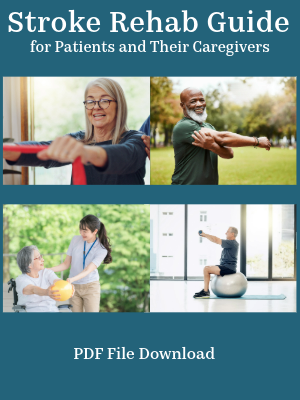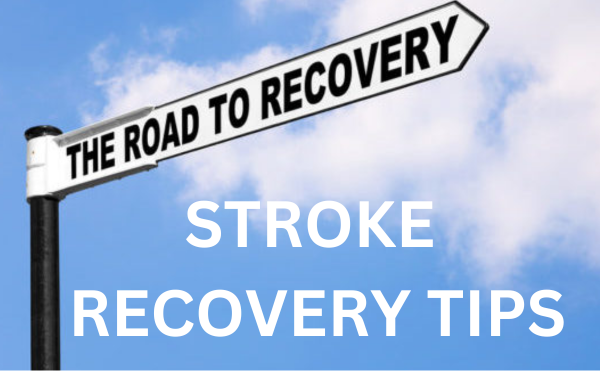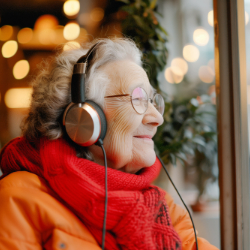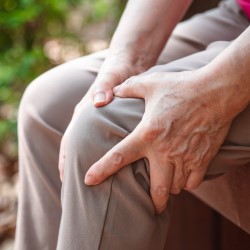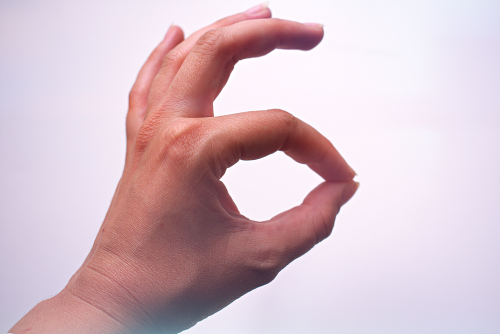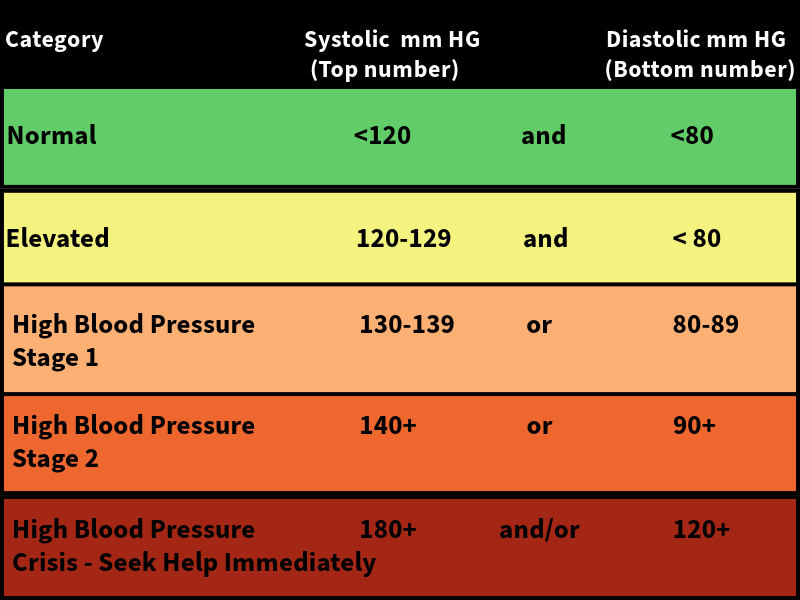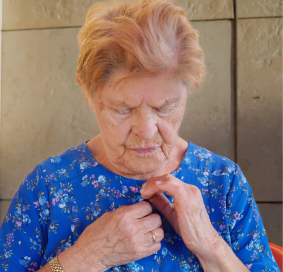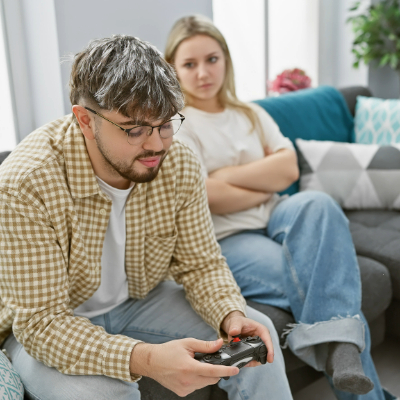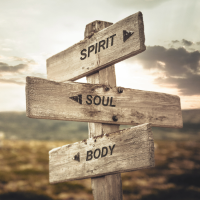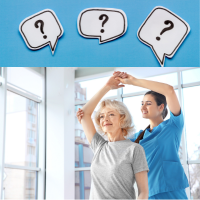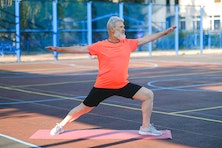Submissions from Readers
Feeling of Falling from a Stroke
Question: My mother had a stroke. Can you please give me some advice as her balance has been affected, and she feels like she is falling. What could we do to help this stop?
ANSWER: Stroke can affect balance in several ways. A stroke victim's fear of falling may be justifiable because one side may be significantly weaker. The muscles on the weaker side may be paralyzed or too weak to hold the person's body weight. Many patients can learn to compensate by shifting weight to their strong side, but they should also work on learning to take weight through the weak side as well. This is often scary at first, and therapy is often required to relearn standing balance. Confidence often grows over time. If your mother is unusually fearful, it is important that she has a therapist she trusts.
There are other factors involved with maintaining balance that have to be considered as well. Three systems that the body uses to maintain balance include the visual, vestibular, and somatosensory systems. Vision can be impaired because of stroke, and sometimes the visual field on the weak side may be cut. If this is the case, the stroke victim may run into things which obviously can increase risks for falls and make the person fearful. Vision retraining would be in order if this is a problem. Vision retraining often involves scanning exercises to the weak side (or learning to turn the head to compensate).
The vestibular system controls the sense of movement and balance and provides information about position of the body relative to gravity. If a stroke has affected the vestibular system, a patient may have dizziness and vertigo. The natural response from persons who have these symptoms is to avoid head movements and activities that exacerbate symptoms. Often patients with dizziness and vertigo are less willing to cooperate during therapy. Vestibular rehab or medication may be in order to help the patient overcome vertigo. A physician can identify if a patient has had a stroke that has damaged the vestibular system. Vestibular rehab should be done by a qualified therapist who has experience with vestibular therapy.
The somatosensory system is involved in balance because it allows us to sense joint position as well as pressure on the feet and hands. If the somatosensory system is not functioning properly, it is difficult for the stroke patient to sense where their body parts are in space and how much weight they are actually taking through the hands and feet. As you can imagine, this could be very scary for the patient when they are standing. Visual compensation strategies or exercises to improve awareness of body position are needed when there are somatosensory problems.
One other factor to consider is medication. Medication can have side effects such as drowsiness and dizziness so it is important to examine medication as a cause of balance problems.
In order to help your mom, I recommend that you have a therapist determine which systems have been affected by stroke and then provide exercises and activities (including home exercises) to help improve these systems. Over time, your mom should gain more confidence and have less fear about falling.
Cerebellar Stroke and Balance Problems
by TULIKA
(BOKARO STEEL CITY)
Question: Does the cerebellum also get affected in a stroke? How do you know whether the cerebellum is affected?
Answer: Yes, the cerebellum can be affected by a stroke. The only way to clearly know what part of the brain is affected by stroke is by imaging studies such as a CAT scan or MRI. These scans may need to be repeated if stroke symptoms persist but no damage was identified at first. The reason for this is that sometimes these studies may miss the stroke if done too early, the area of damage is too small, or if the damage is in an area that is difficult to visualize on the imaging study. The effects of a cerebellar stroke often are:
* Impaired coordination and balance
* Ataxia
* Dizziness
* Direction changing nystagmus or multi-directional nystagmus
The patients I see with cerebellar stroke often retain movement but present with uncoordinated movements or gait, decreased balance, and often complain of being dizzy. Symptoms can vary person to person though depending on the extent and location of damage.
If you think you are experiencing stroke symptoms, seek medical attention immediately.
Balance Problem After Stroke
by shamkumarsharma
(new-york,usa)
Question: I have a balance problem as my left side is paralyzed. I had heart attack and after bypass surgery, I had a stroke at night. I have problem in balance and every time I walk, I have to bend on my left side to keep from falling. I do not like physical exercises and want some medicines to improve it.
Answer: It is outside of my scope of practice to recommend medications. There are medications that help with dizziness and spasticity, but if your balance is due to weakness or paralysis, it is unlikely to improve without practicing balance exercises. Consult your physician regarding medications that might be of benefit to you. I hope you will consider adding exercises to help improve your balance as I think that is your best bet.
BALANCE REHAB
by Evie
(Illinois)
Question:I had a cerebellar stroke on 9/23. Is there a DVD I can purchase that contains balance exercises? I have problems with balance/vision since the stroke.
Answer: I would not be able to recommend a specific DVD since I have not viewed any of them, but there are DVDs that have balance exercises. I recommend doing a search for "balance exercises DVD" and "stroke balance exercises DVD" on a search engine. You can also search on YouTube for these terms which will provide you with some videos and possible even small bits from DVDs on the market. There is a website called exerciseforbalance.com that offers a DVD put together by a physical therapist who has experience with balance and dizziness disorders. I am not familiar with the DVD, but the website pulled up when I did a search for balance exercises for stroke, and it may be worth looking over.
Difficulty with balance and walking?
by Stephanie Lambert
(New Orleans, LA)
Question: What exercises are recommended for difficulty with balance and walking 11 months s/p stroke?
Answer: There is not a specific set of exercises recommended for patients based on how long it has been since they've experienced a stroke. The type of balance exercises one may need would depend on how the stroke affected the individual including sensation, muscle weakness, proprioception, pain, spasticity, cognition, vestibular function, and a host of other factors. Some patients cannot even stand after 11 months. Other patients can walk without any obvious deficits. There is really no way for me to answer your question as the individual would have to be evaluated for their specific needs. I will try to give you the general progression of balance exercises though in simplistic form. The progression in balance may look something similar to this:
1)Learning postural control in order to sit up unassisted first in a static (non-moving) position and then with a dynamic component (e.g. sitting while reaching for something without falling over). Sitting balance exercises would involve shifting weight side to side, forward and back, and advance to weight shift while using arms.
2) Next, one would progress to learning sit to stand, however, sometimes, patients have difficulty achieving this on their own and may need continued help to get to a standing position. Sit to stand can be facilitated by using a hi lo mat in a raised position if the patient has trouble getting up from a low surface.
3) Once standing, the patient will work on static balance and trying to take weight through the weaker leg and maintaining equal weight through both legs. If one leg is severely paralyzed, a patient may not be able to maintain weight through the weak leg. Some patients will have increased spasticity in the weaker leg which sometimes can actually keep the leg straighter and keep it from buckling. Just as in sitting, the patient will first work on maintaining balance in standing with arm support and simple weight shifting.
4) Next one will add a dynamic component to standing such as stepping forward, back and side or learning to stand without arm support if able.
5) Next one will learn to try and walk. There are various components to gait which are beyond the scope of this discussion, but one's physical therapist could help a patient determine what is needed to improve gait.
6) Other balance exercises one may learn would be trying to get up and down from the floor, standing on one leg, tandem gait, walking backwards, adding arm movements, and other more advanced balance exercises.
Many stroke patients are high fall risks so exercises should be taught by a therapist and done with the therapist or trained caregiver. I know that probably doesn't answer your question, but the best response I can give you is to have the specific patient see a physical therapist for an evaluation of their exercise needs.
Weak Right Hand and Legs Without Balance
by Erma M. Berzuela
(Lucena City Philippines)
Question: How can he attain balance? Is there any device for that? I am in the Philippines.
Answer: One should see their physical and occupational therapist to help them regain balance and hand function. The progression for balance generally goes as follows. First, one should be able to do sitting balance exercises without losing balance. See www.stroke-rehab.com/balance-exercises.html for examples of sitting balance activities. Once a patient can do these sitting balance exercises, they should work on sit to stand with the assist of a therapist or trained caregiver. Once standing in place is achieved, the patient will work on weight shifting and steps. I go through the progression of these exercises at www.stroke-rehab.com/difficulty-with-balance-and-walking.html.
There are devices that assist with standing and walking such as the Lite Gait which involve putting the patient in a harness and allowing the patient to stand and attempt to take steps with only partial weight bearing. The harness helps suspend the patient and take away some of the weight. I am not familiar with the rehab facilities in the Philippines so I do not know if there are facilities that have this type of device. There are other devices on the market as well. Here is a website with pictures of the device:
http://litegait.com/products/adult-litegait
For attempting to regain hand function, you can visit www.stroke-rehab.com/stroke-hand-rehab.html.
I also have a stroke rehab e-book that provides pictures for all types of exercises including leg/balance/arm exercises as well as resource information for patients and caregivers. It is available online for $14.99 at www.stroke-rehab.com/stroke-rehab-ebook.html
Imbalance/fall issues
by Lisa
(Buffalo, NY)
Question: My name is Lisa Peterson and I am inventing a toileting device for stroke victims that supports the entire spinal column. It is light-weight and folds to 180 degrees for easy storage. I am working with my local University on this project. Just wanted to get your feedback on whether you feel there is a need for such a device to assist your patients while toileting. I am not including the picture due to the fact that it is intellectual property with a patent pending. Thank you so much for your help!
Answer:: Hi, Lisa. Without seeing it, it's hard to know, but it sounds like something that would benefit patients who do not have good trunk control. Many acute stroke patients in hospitals and inpatient rehabs tend to lean backwards at first when sitting so it seems like something to support their spinal column would be beneficial.
strength exercises to get up from a sitting postion
Question: I had a stroke over a year and a half ago. I am still not able to get up from a chair if its too low. I am able to get up from my bed and a stool but not a regular chair. What exercise if any can I do to strengthen this muscle? I am not sure if its my knees or backside that is too weak thank you so much for this site. I really would like to improve I am embarrassed in public trying to get up. Thank you for your time.
Answer: The exercise I like to have patients do for getting up from a low surface is to use a hi-lo mat. This mat can be raised or lowered to various heights. I find the height that is difficult but not impossible for the patient to stand up from and practice sets of sit to stand from this height. I work on bringing the mat down a little bit lower over time until the patient can get up from a lower surface (without arms if possible). Obviously, unless you are at a rehab gym, you probably do not have access to a hi-lo mat. What you could purchase to recreate the activity at home though is a portable power lift seat (they range in price from $100 to $230). You could place the lift seat on a low surface and then use the lift mechanism to practice getting up at different heights until you are able to get up from the lower height of a regular chair.
Balance Issues
Question: I had my stroke in August 2004 and I have regained most of my strength but very little balance control. I walk with a quad cane yet feel like I'm always on a razor edge, just a half a step from a fall.
My stroke was a subdural hematoma of the right cerebellum and caused my right side to be affected. What kind of doctor might help me? I've tried every "gimmick" that I hear of as well as years of P,T., gym exercises, a personal trainer and recently started yoga. I saw a lot of progress for the 1st year or two but very little or none in the last 5 years.
Is there anything that you would suggest that I read? I'm not desperate but I'm running out of options or things to try. I'm only 55 right now and would like to have a little more independence.
Any thoughts are welcome thoughts.
David Crook
david@rcwarplanes.com
Answer: As you probably know, the cerebellum is instrumental in maintaining balance so damage to this area can wreak havoc on one's ability to maintain balance. It is not uncommon to have ataxia with a cerebellar stroke. I found an article that describes ataxia and rehab exercises to address which I think is worth a read and have included the link below my response.
I know you said you have tried all types of therapy and exercise so I may not be able to offer anything new, but I do want to mention ideas in case you haven't tried them. Attempting balance activities with a visual component is important meaning with eyes closed, eyes opened, exercises involving visual tracking and gaze stabilization in various positions. When I say various positions, I mean progressing from sitting, kneeling, on hands and knees, standing, standing on one leg, etc. One balance activity that comes to mind as well is the Infinity Walk. You can google the term and will be able to find information and YouTube videos demonstrating the activity.
You should makes sure you have a trained individual to help you when attempting activities that challenge your balance because you do not want to fall, and I always recommend checking with your MD or therapist before attempting new exercises.
Here is the article that I mentioned previously:
http://cirrie.buffalo.edu/encyclopedia/en/article/112/
I would encourage you to search information regarding cerebellar ataxia and balance, vestibular rehabilitation, and cerebellar stroke. You may not have ataxia, but I think some of the suggested exercises used with ataxia may be helpful to you. The best advice I can give you is to keep doing what you're doing to maintain and hopefully improve, and do not give up!
Comments for Balance Issues
|
||
|
||
|
||
Walking challenges
by Maureen
(Glenview, Il)
Question: I suffered a stroke 5 years ago. I had a heart transplant 3 years ago and did my rehab post-transplant. After a year I was released as functional as I was able to walk with an assist device. I exercised regularly and no longer use the device but I still can't walk properly. I have foot drop and my toes still catch the ground occasionally and anyone can hear the slap as I approach. I can't kick the ankle on my affected side out in front of myself properly when walking and The knee on my affected side wants to turn out and I have a lot of pain in the hip on my affected side. When I try to walk more quickly or longer the back of the knee on my affected side hurts as if it's been hyperextended. What kind of exercises are available to move from "functional" to truly functional?
Answer: You can try traditional knee and ankle exercises, but if you find they do not help, you might want to consider kinesiotaping the foot or leg or using an AFO (ankle foot orthoses). I know that sometimes people do not want to use an AFO, but if you are at a risk from falling due to drop foot and are also having hip pain, it may be something you want to consider. Kinesiotaping would be a less invasive measure than a brace, but it may not provide enough help. For examples of exercises to improve drop foot and knee strength, you can view:
https://www.youtube.com/watch?v=rTjwb6NOPUU
https://www.youtube.com/watch?v=yTJfCHxdZYU
Can exercise still help 4-5 years after stroke?
by Marie
(Brooklyn, NY, USA)
Question: I had a stroke about 4-5 years ago and haven't been to therapy in more than two years. Balance is very poor. Can balance exercises help? It has been almost 5 years.
Answer Balance exercises can definitely help especially if you haven't been doing anything to address balance over the last couple of years. Also, I don't know how old you are, but it is not unusual for balance to decrease as we age so balance exercises are good not only for those that have had strokes but even for those who have not had strokes. Balance and flexibility exercises are very important as we age as they can help improve or maintain our mobility and prevent us from getting stiff and having difficulty with everyday activities (e.g. such as dressing).
HOW TO IMPROVE VERY POOR BALANCE
by GEORGE
(ONT. CAN.)
Question: Hello! I had a massive ischemic stroke back in 2011 and still cannot walk. As a result I also have very poor balance I have fractured my pelvis 3 times from falling. Is there a way to improve very poor balance. Thank you. reid80500@gmail.com
Answer: In your case, I think you need to consult with a physical therapist who specializes in working with stroke patients. Many therapists will say they have experience, but you want someone that has a verified history of working with difficult cases and helping them to stand/walk (ask if they have reviews/or get a referral from someone). If you have exhausted therapy, then you might see if you could find an experienced personal trainer who has worked with stroke patients and injuries. The key is that you need a professional who has a lot of experience. I would say you also need to go to a facility that has specialized equipment to help you. With the number of falls and injuries you've had, I would definitely work with a trained professional rather than trying to do something on your own.
Sitting balance
by Shida
(Sweden)
Question: I am a physiotherapist who just recently began to rehabilitate stroke patients. Now I have a patient who can sit on the bed and extend his arm beyond the arms length in different directions to reach different objects without losing balance but when he just sits and then begin to talk he gradually loses balance towards left side. Why is that?
Answer: When he actively is thinking about maintaining his balance he is able to overcome his left side weakness either by consciously activating the muscles more or by compensating with right side strength. When he becomes distracted or fatigued, the left side weakness becomes more obvious. He needs continued work on left side strength and balance.
Treatment Tips from Others
To see tips from other survivors and caregivers about their treatment recommendations, click here.
Get Our Stroke Rehab Guide

Our stroke rehab guide is designed specifically for patients and caregivers. It's in pdf format and can be immediately downloaded. It includes about
- Stroke Definition & Causes
- Stroke Treatment
- Rehabilitation Information for Physical, Occupational and Speech Therapy
- Exercise pictures
- Q&A from patients and caregivers
- Adaptive Equipment & Techniques
- How to Prevent Another Stroke & More!
Medical Disclaimer: All information on this website is for informational purposes only. This website does not provide medical advice or treatment. Always seek the advice of your physician or other healthcare provider before undertaking a new healthcare or exercise regimen. Never disregard professional medical advice or delay seeking medical treatment because of something you have read on this website. See the disclaimer page for full information.
- Home
- Stroke Questions
- Sitting balance


